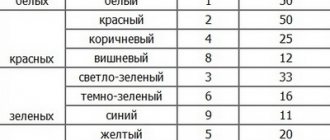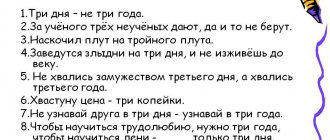Summary of a lesson on FEMP in the preparatory group. Composition of the number 10
A lesson on the formation of elementary mathematical concepts in a preparatory group with OHP on the topic “Help Mashenka return home”
Purpose: to introduce children to the composition of the number 10 from ones. Objectives: I. Educational:
- Continue to teach how to make the number 10 from ones.
— Introduce the writing of the number 10. — Strengthen the skills of counting forward and backward within 10. — Strengthen the ability to correlate numbers within 10 with the number of objects. — Strengthen children’s ability to lay out the number 10 from counting sticks. — Strengthen children’s ability to lay out a number line within 10. — Strengthen children’s ability to name the previous and subsequent numbers and their neighbors. II.
Developmental: - Development of mental processes: memory, attention, logical thinking.
— Development of fine motor skills. — Development of coherent speech. III.
Educational: - Improve the moral and volitional qualities of students through the development of perseverance, the ability to listen to the interlocutor, and make their own judgment.
Material: Mashenka’s illustration, numbers from 1 to 10, diagram, symbols: numbers from 1 to 4, cards with a group of objects (from 1 to 10), coloring books, pencils, pencil cases, counting material, notebooks, copybooks, magnetic board, circles one size from 1-10, number series from 1-10, counting sticks, ball Move
1.
Introductory part Organizing children in a circle. - Guys, look, this morning I found such a diagram in the group, it shows numbers, and behind the diagram there is text, let's read and find out why these numbers are drawn, listen carefully: “Hello, children! Help me, please, I went for a walk in the forest, and came back late in the evening, it was already dark and I got lost, and now I can’t find my way home. This diagram will help you find my way home. Sincerely, Mashenka!” - Guys, who needs our help? Shall we help? - The diagram shows numbers from 1 to 4. - In our group, these numbers are also hidden, you need to find them and complete the tasks. If we complete all the tasks correctly, Mashenka will be able to find her way home. 2. Main part - What is the first number? (one) - We are looking for the number one in the group. Children search in groups. The teacher reads the first task from the envelope. — The first task is called “Name the number” (performed on the carpet in a circle). I will tell you a number, and you need to name its neighbors, the number that comes before it and after it. The teacher throws the ball to the children one by one and names the number, and the children name its neighbors.
- Well done, and now I tell you the number, and you give me the one that stands behind this number.
- You completed this task correctly. Go ahead. What is the next number in the count? (two) - We are looking for the number 2 in the group. Children search in the group. - From number 1 to number 2, we need to draw a line on our diagram so that Mashenka finds her way. The child draws a line with a pencil. The teacher reads the second task from the envelope.
— The second task is called “Make up the number 10.” It is performed at the tables.
- Guys, sit down at the tables. - Tasya, come to me and count how many circles there are on the board. The child is counting. — How is the number 10 composed? (1 pink circle, 1 red circle, 1 yellow circle, etc.) - Masha, come to me and lay out a number line from 1 to 10 on the board, and take the rest of the numbers from the pencil case and lay them out in front of you. - Show us how the number 10 is indicated. The child points to the number 10. - Anton, go out and count the numbers, and now in reverse order. — Guys, did Anton count correctly? - Well done, sit down. - Now take 6 counting sticks and put the number 10 on them. I check with each child that the task is completed correctly.
- Well done, you laid everything out correctly.
Put the counting sticks back in place. - After number 2, what is the next one? (three) - We are looking for the number three in the group. Children search in groups. — From number 2 to number 3, draw a line. - The next task is called “Match” - I will distribute cards to each of you. Some people have a number shown, but others have a group of objects and need to find a pair, the number of objects must match the number. Children look for a mate and stand with each other. - Well done, now let's exchange cards. The teacher changes cards for the children. - We completed this task. After number 3, what is the next one? (four) - Look for the number four in the group. Children are looking for a number. - This is our last figure in our scheme. Let's draw a line from number 3 to number 4. The child draws the line. - The fourth task is called “Write down the number 10” - Sit down at the tables. Open your notebooks. I show the children the required task that needs to be completed. — With a pencil, circle the number 10 along the dots. I check with each child that the task is completed correctly. - Well done, close your notebooks and move them to the edge of the table. 3. Final part: - There is one last task left. I will ask you questions, if you answer correctly, you will receive a piece of the puzzle, once we collect all the pieces, then we will be able to help Mashenka return home. Questions: 1. Name a geometric figure with three angles. (triangle) 2. How many sides does a square have? (4) 3. Name the neighbors of the number 8 (7 and 9) 4. How many legs does the table have? (4) 5. What day of the week comes after Thursday? (Friday) 6. What geometric figure does an egg resemble? (oval) 7. How many seasons are there? Name them (4. Autumn, winter, spring, summer) 8. Count in order from 0 to 10. 9. What day of the week comes after Sunday? (Monday) 10. Name the parts of the day (morning, afternoon, evening, night) - Well done, you answered all the questions correctly, we got all the details. Let's see what we got. - Yes, guys, this is Mashenka. She found her way home and says thank you very much for your help and gives you small gifts. - Let's say goodbye to Mashenka. - Goodbye, Mashenka!
We recommend watching:
Summary of GCD for children of the preparatory group. How to be able to count well. Notes on educational activities in mathematics in a preparatory group for school. Notes on educational activities on FEMP in a preparatory group with a presentation. Notes on the educational situation on FEMP in the preparatory group of a preschool educational institution.
Similar articles:
Summary of mathematics lessons in the preparatory group. Pentagon
Summary of mathematics lessons in the preparatory group. Repetition of what has been learned in the senior group
Abstract of GCD in mathematics in the preparatory group. Solving logical problems
Abstract of GCD in mathematics in the preparatory group on the topic: Area
Abstract of GCD in mathematics in the preparatory group. Tangram
Composition of the number 10
An intensive lesson on the composition of the number 10 trains children in counting.
A common stream of knowledge has a beneficial effect on class cohesion. Goal
: consolidate knowledge of the composition of the number 10.
Tasks
:
- improve the ability to perform tasks that require knowledge of the composition of the number 10;
- write down expressions based on the picture or correlate those proposed with the picture;
- perform grouping of numbers;
- identify patterns;
- develop attention, memory, logical thinking, imagination, mathematical speech;
- cultivate interest in the subject, accuracy, sense of camaraderie and mutual assistance.
Equipment
: drawing for the riddle, model of a droplet, cards with numbers, geometric shapes - small and large squares of different colors, drawing of a “magic wheel”, a stack of notebooks, punched cards, a droplet for each student.
Progress of the lesson
Teacher
: Guys, hello. Look outside the window, what time of year is it now?
Children
: Autumn.
Teacher
: What has changed in nature?
Children
: It gets dark early, a cold wind blows, and it rains often.
Teacher
: Indeed, if you look at the window in the rain, it’s all filled with small droplets.
Teacher
: Each of our drops is special, it is not simple and offers you a task. If we quickly and correctly complete the task, then this drop falls into the stream of knowledge, which is still small.
Teacher
: Unravel the rule by which the series of numbers is composed, and continue it (
single-digit numbers only
). 4, 6, 5, 7, 6, …, …, …, …
Children
: 4, 6, 5, 7, 6, 8, 7, 9, 8 (
frontal check
).
Teacher
: Reduce each number in the row by 3. The answers are given on the back of the board.
( Children conduct a self-test
.) 1, 3, 2, 4, 3, 5, 4, 6, 5,
Teacher
: We completed the task, and the first drop falls into the stream of knowledge (
we place a drop in the stream
).
Teacher
: There are cards with numbers 1-9 on the board. I say the task, you must think and choose a card with the desired answer:
- How much greater is the number 8 than the number 4?
- How much is the number 7 smaller than the number 9?
- reduce the number 9 by 3;
- increase the number 2 by 1;
- What is the sum of the numbers 2 and 5?
- what is the difference between the numbers 7 and 6?
Children
: 4, 2, 6, 3, 7, 1 (
frontal check
).
Teacher
: Insert numbers instead of dots to make correct entries.
You can only use the numbers obtained in the first task. … + …=… — … … — …=… — … … + …=… + … ( The task is completed independently in notebooks, then checked at the board. All answer options are considered
.)
Teacher
: We completed the task, and the second drop falls into the stream of knowledge (
we place the drop in the stream
).
Teacher
: Name the numbers that need to be inserted into the “windows”.
( Students name the numbers, go to the board and turn over the cards: 3, 9, 5, 1, 6, 10.
)
Teacher
: Name the extra number.
Children
: 10.
Teacher
: Why?
Children
: Two digits, one ten.
Teacher
: Think about what goal of the lesson we set? For what?
Children
: Repetition and consolidation of the composition of the number 10, so that later you can easily and quickly perform addition and subtraction.
( Message of the topic and objectives of the lesson
.)
Teacher
: We completed the task, and the third drop falls into the stream of knowledge (
we place the drop in the stream
).
Teacher
: I have a stack of notebooks. How many are there?
Children
(
consider
): 5.
Teacher
: I added a few more. How many has it become?
Children
(
consider
): 10.
Teacher
: How many notebooks did I add?
Children
: 5.
Teacher
: How did you get 10?
Children
: 5 + 5=10. (
The expression is written on the board and in a notebook
.)
Teacher
: Figures are given. Name them. On what basis should all figures be divided into two groups so that this corresponds to the expression 5 + 5?
Children
: By color.
( The student at the blackboard divides the figures into two groups by color
.)
Teacher
: By what other criteria can the figures be divided?
Children
: To size.
( The student at the board divides the figures by size into two groups and writes down the expression 6+4=10, 4+6=10. Children write in a notebook
.)
Teacher
: Let's take a break and have some exercise.
Hamster-hamster, hamster, Striped flank. The hamster gets up early, washes his cheeks, rubs his neck. The hamster sweeps the hut and goes out to exercise. One two three four five! Khomka wants to become strong. ( Children imitate all the movements of the hamster
.)
Teacher
: Here is the game “Magic Wheel”.
Arrange the numbers from 1 to 9 so that in any direction along a straight line the total is 10. ( Students go to the board and write down pairs of numbers.
)
Teacher
: Now let’s write new expressions on the board and in the notebook: 1+9=10;
9+1=10; 2+8=10; 8+2=10; 3+7=10; 7+3=10. Read all the expressions ( entries in your notebook
). We completed these tasks, so all the drops fall into the stream of knowledge.
Teacher
: Now we have to work according to the textbook by N.B. Istomina.
( Page 125 No. 291, work in pairs
.) Look at each pair of drawings. What's happening?
Children
: The number of circles increases.
The 1st pair
explains
: the number of red circles was increased by 2, it became 10 (8+2).
2nd pair
: the number of yellow circles was increased by 4, getting 10 (6+4).
3rd pair
: the number of green circles was increased by 5, resulting in 10 (5+5).
4th pair
: the number of blue circles was increased by 3, getting 10 (7+3).
Teacher
: What case is missing?
Children
: 9+1=10
Teacher
: Open your notebooks (TPO). Page 37 No. 79. We complete the first task with an explanation. There are 4 circles in a triangle. What number was used to write this number?
Children
: 4.
Teacher
: How many circles do you need to draw to 1 dozen?
Children
: 6.
Teacher
: How many circles are there in total?
Children
: 10. To write this number, we use two digits: 1 and 0. (
Then the task is completed independently. After completion, check
.)
Teacher
: You have a punched card on your table, with which I will check how you have mastered the composition of the number 10. And I will decide whether to drop our last drop into the stream of knowledge or not after checking the work completed.
Teacher: Let's summarize. What did you repeat in class? Which tasks did you like best? Each of you has a small drop on the table. If you are sure that you know the composition of the number 10 well, and did not have difficulty completing tasks, then your drop falls into the stream of knowledge. If someone is not confident in themselves, let this droplet stay with you for now. And when you are convinced of your knowledge, then drop a drop into the common stream. Maybe it will be tomorrow. ( Children go to the board and drop their drop into the “trickle of knowledge” envelope
.)
Tatyana Gavrilova, primary school teacher, MBOU "Secondary School No. 29
with in-depth study of individual subjects", Smolensk







